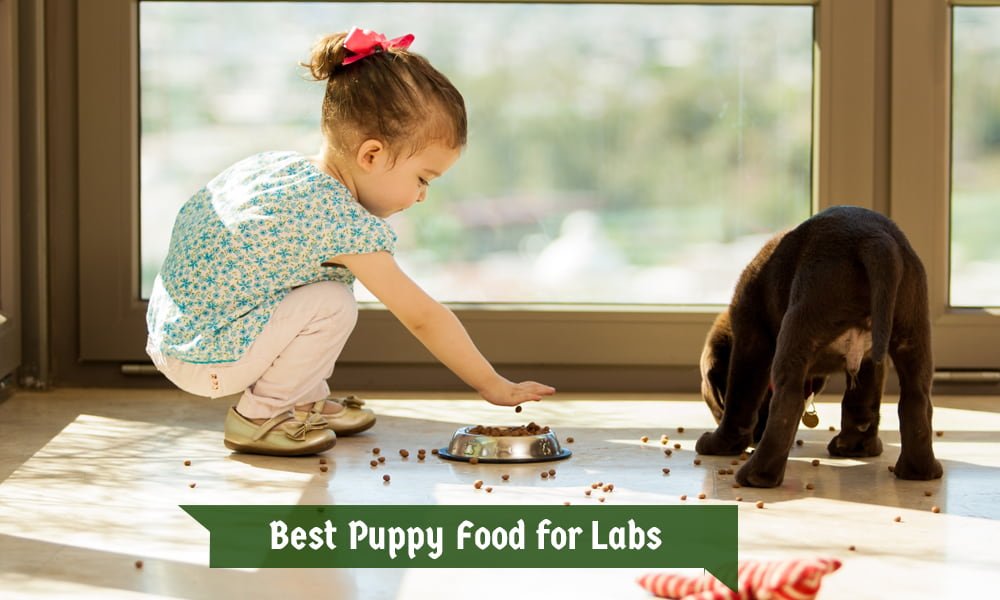
It’s not hard to see why Lab puppies need special food. This big, lovable dog has boundless energy. Compare them to a smaller puppy, like chihuahuas and pugs, and you can see that a Lab puppy has different nutrition needs to help them grow into their adult Labrador Retriever bodies. That’s why finding the best puppy food for Lab breed dogs is so important.
Contents
- What should I feed my Labrador puppy?
- What are the best foods for Labrador puppies?
- How much should I feed my 8 week old lab puppy?
- 1. Royal Canin Breed Health Nutrition Labrador Retriever Puppy Dry Dog Food
- 2. NUTRO WHOLESOME ESSENTIALS Puppy Dry Dog Food
- 3. Hill’s Science Diet Dry Dog Food Large Breed Lab Puppies Chicken Meal & Oats Recipe
- 4. Eukanuba Puppy Dry Dog Food Chicken – Large Breed
- 5. Wellness CORE Rawrev Natural Dry Dog Food Puppy
- 6. K9 Natural Grain-Free Freeze-Dried Puppy Food
- 7. Blue Buffalo Life Protection Formula Large Breed Puppy Dog Food
- 8. Blue Buffalo Wilderness High Protein
- 9. Instinct Puppy Grain-Free Recipe Natural Dry Dog Food
- 10. Taste of the Wild Dog-Food High Prairie Puppy Food
- 11. Purina Pro Plan Dry Puppy Food
- Wet vs Dry Food for Puppies
- The best large breed puppy food helps your Lab puppy dog grow into a healthy adult.
What should I feed my Labrador puppy?
One of the main differences between Lab puppies and smaller breeds is that Lab puppies have a lot more growing to do. For example, a Cavalier King Charles spaniel weighs about 8 pounds at three months old and grows to an adult size of about 15 pounds, their weight just about doubling. A Labrador puppy, on the other hand, weigh about 20 pounds and three months to about 65 pounds, more than tripling their weight.
Because of this, large breed puppies grow and change a lot in the first few years, going through fast and dramatic bone changes. This makes them very sensitive to nutritional imbalances, which is why using the best puppy foods formulated for Labs helps them get the protein content and nutrients they need to promote healthy growth.
Watching your Lab puppy’s weight is key to helping them grow properly, too. If they’re too heavy, it puts too much pressure on their growing bones which can cause a lot of problems for them later in life. That’s why Labrador specific puppy food and large breed puppy foods in general have fewer calories and fats than other puppy foods. That said, puppy food has more calories and vitamins than adult puppy food to support their rapid growth.
Labs do not reach adult size until they are between 12 and 18 months old, and you should keep feeding them puppy foods throughout this time. When they’re fully grown and no longer puppies, switch to the best breed-specific dog food to make sure your adult Lab doesn’t get too many calories and fat. If you’re not sure when to switch, ask your veterinarian.
What are the best foods for Labrador puppies?
It’s tempting to try to save a few bucks and buy the most affordable puppy foods, but this is not the best option. That’s not to say that all inexpensive options are nutritionally incomplete for puppies, but they are usually made with lower quality ingredients so it’s really important to read the labels. It’s very important not to skimp when it comes to your pet’s health, and by only looking at the price tag, there’s a good chance your Lab puppy isn’t getting what they need.
How much should I feed my 8 week old lab puppy?

The exact amount for Labs and other puppies depends on what ingredients are in the puppy foods you’re using. There should be detailed instructions on the side of the best puppy food for Labs packaging that tells you how much to use depending on the age of your puppy. A general guideline is four meals of two ounces per day at two months, three meals a day of about 3.5 ounces at three months, and two meals of six to eight ounces a day at six months.
Again, this is just a guideline. The best thing to do is follow the instructions on the package or ask your vet to be sure. Keep a close eye on your puppy, too. If they appear to be gaining weight, you may need to cut back a bit.
If you’re looking for the best puppy food for Labs, here are some of the best options available, each of which keeps your Labrador puppy’s health in mind.
1. Royal Canin Breed Health Nutrition Labrador Retriever Puppy Dry Dog Food
Our top pick for the best puppy food for Labs is this breed-specific food from Royal Canin. Choosing breed-specific food from a well-known brand is usually a safe bet, and this is definitely the case with Royal Canin.
This recipe is designed to meet the specific nutritional needs of Lab puppies between eight weeks and 15 months. The unique ring-shaped kibble is meant to help Lab pups chew and eat their food more slowly, which makes every meal more satisfying.
In addition to providing your puppy with the best nutrition it needs to thrive, Royal Canin also includes an effective blend of antioxidants to help boost their developing immune system and proteins and probiotics to support optimal digestion. It promotes healthy bones and weight management to help your Lab become a healthy adult.
There’s a feeding table on the package that suggests feeding amounts for puppies at every stage of puppyhood, from two to 14 months. This 30-pound bag should last you quite a while, especially when your puppy is very young. Store it in a large air-tight container to keep it fresh between feedings.
Another great thing about Royal Canin’s puppy foods is they make adult breed-specific food, too. So, when your puppy reaches adulthood, transitioning to Royal Canin’s adult Labrador food is easy. Best of all, Royal Canin’s breed-specific health formulas are all 100 percent satisfaction guaranteed.
2. NUTRO WHOLESOME ESSENTIALS Puppy Dry Dog Food
A good large breed puppy food that’s good for Labs is Wholesome Essentials by Nutro. Farm-raised chicken is the first ingredient, which tastes great and provides the protein your puppy needs for healthy growth.
This food also contains omega-3 and 6 fatty acids like DHA for brain development and to promote your Lab’s shiny coat and healthy skin. There’s also calcium to support bone growth and joint health and a unique blend of brown rice, sweet potatoes, and other vegetables to deliver the nutritionally rich food your puppy needs to grow.
This best Lab puppy food doesn’t contain artificial flavors, colors, or preservatives and it is made using non-GMO ingredients. It’s available in a five and 15-pound bag so you can choose the size that works best for your puppy. A detailed feeding schedule is included on the package so you can be sure your puppy is getting the right amount of food every day.
This natural dog food is also available in a lamb formula. While it also delivers complete nutrition, it’s only meant to feed your puppy for one year, which means you’ll have to transition to another puppy food at that time to bridge the gap until adulthood. The best food for puppies from this brand is the chicken recipe.
3. Hill’s Science Diet Dry Dog Food Large Breed Lab Puppies Chicken Meal & Oats Recipe
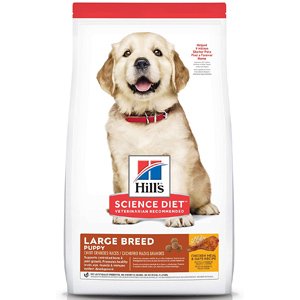
This best large breed dry puppy food is great for puppy Labs. It contains the optimal amount of calcium to support controlled bone growth and balanced minerals strong bones and teeth. Puppies love the delicious chicken flavor and the high-quality protein helps them develop and maintain lean muscle. Fish oil provides DHA for healthy brain and eye development, too.
Something impressive about this brand is that its recipes are developed by a team of more than 200 food scientists, vets, and Ph.D. nutritionists. They carefully choose their suppliers by making sure their facilities meet a high bar of safety and quality standards and each ingredient is examined to make sure it delivers the nutrition necessary to keep the recipe balanced for your pet.
Hill’s Science Diet is made in the USA with the best ingredients sourced from all over the globe. It’s the number one veterinarian-recommended brand because it gives you pets the best start in life so they can grow into healthy and happy adults. This dry Labrador puppy food uses only natural ingredients with no artificial preservatives, colors, flavors, or chicken by-product meal. Plus, with every purchase, Hill’s donates food to animal shelters across the country, feeding over 100,000 homeless pets every day.
4. Eukanuba Puppy Dry Dog Food Chicken – Large Breed
Another best food puppy for Labs is this large breed option from Eukanuba. It’s meant for Labrador puppies through 15 months old for breeds expected to weigh over 55 pounds. High-quality chicken is the first ingredient, proving the lean protein your Lab needs for energy and to support lean muscle growth.
This formula also contains optimized levels of phosphorus and calcium to support bone health, DHA for healthy brain development, and vitamin E to help a developing immune system, all ingredients to help your large breed puppy grow into a healthy adult Labrador retriever. Concentrated energy provided by the appropriate level of carbohydrates and fat keeps your puppy going, playing, and exploring while continuing to grow.
There are three sizes available so you can choose the size appropriate for your Lab puppy. Whether you choose a five, 16, or 33-pound bag is up to you. Serving sizes for Lab puppies are listed on the side of the bag for Labrador puppies at ages two, five, eight, and 12 months. Eukanuba is so sure you and your puppy will love this best dog food, satisfaction is guaranteed.
5. Wellness CORE Rawrev Natural Dry Dog Food Puppy
This high-protein, nutrient-dense dry large breed Labrador puppy food for Labs from Wellness CORE uses 100 percent raw freeze-dried turkey that provides the right amount of protein and calories to support your Lab puppy’s high energy as well as a taste it will love. The naturally grain-free kibble also includes turkey and chicken meal for concentrated protein which also delivers the DHA your puppy needs for healthy brain and eye development. This high amount of protein also develops leaner muscle mass.
There are a lot of other great ingredients in this best puppy food for a Labrador puppy, too. Omega fatty acids from flaxseed and salmon oil develop a healthy coat and skin, antioxidants for a healthy immune system, glucosamine for healthy joints, and probiotics to encourage effective digestion. Plus, there are no fillers like wheat, soy, or corn.
Wellness CORE is made in the USA from globally sourced non-GMO ingredients, carefully chosen for their nutritional benefits. You can get this dry food in four or 10-pound bags so you’ll have just what you need for your little pup.
6. K9 Natural Grain-Free Freeze-Dried Puppy Food
If you’re looking for great natural puppy food for Labs, take a look at this freeze-dried recipe from K9 Natural. It’s a little on the pricey side, but it’s loaded with goodness that will help your puppy grow into a healthy, strong adult.
Here’s what you won’t find in this best dog food. There are no fillers or gelling agents, GMOs, animal meals, or legumes and they never use any artificial colors, flavors, or preservatives. What you will find is whole, nutrient-rich food ingredients and the right amount of fats and vitamins to support whole growth and development.
This recipe uses grass-fed beef from New Zealand along with fresh Hoki oil obtained from sustainably sourced fish. Every serving provides DHA for brain and eye development, phosphorus and calcium to support teeth and bone development, and premium protein for energy and muscle development.
The best thing about this brand is that it was developed by a vet who looked at the evolutionary standpoint of dogs and their diets. Before dogs were domesticated, their diet consisted of raw animal proteins with minimal carbs and a high amount of fat and protein. So much pet food these days contains carbohydrates, which is why K9 Natural was developed.
Another great thing about this large breed recipe is your Lab puppy is going to love the taste. K9 Natural is so sure about this that they provide a no questions asked money-back satisfaction guarantee.
7. Blue Buffalo Life Protection Formula Large Breed Puppy Dog Food
Blue Buffalo is another well-known brand of dog food, and their large breed puppy formula is perfect for your Lab. They always use real meat as the first ingredient, like the high-quality real chicken in this recipe that encourages healthy muscle growth. This puppy food also contains DHA and ARA, fatty acids present in breast milk that contribute to the development of the brain and eyes.
A cool thing about Blue Buffalo is that they include something called Lifesource bits in their dry dog food. These are kibble-sized bites that contain a precise mix of vitamins, minerals, and antioxidants that have been specially blended to support your puppy’s immune system and life stage requirements.
This is also a great choice if you’re looking for natural dog food. It uses the finest ingredients and contains no poultry by-product meals, corn, wheat, or soy as well as no artificial preservatives or artificial flavors.
The large breed kibble size is also perfect for puppy Labs. It’s small enough for them to eat easily and encourages them to take their time chewing while cleaning their teeth and removing tartar. This product comes in two sizes, 15 and 30 pounds, so you can get just what you need.
8. Blue Buffalo Wilderness High Protein
Another option from Blue Buffalo is this high-protein puppy formula that specially blended to satisfy your puppy’s instinctual love for meat. It uses real chicken to encourage strong muscle growth as well as many other healthy ingredients. It’s grain-free but provides quick carbohydrate energy in the form of peas and sweet potatoes as well as omegas 3 and 6 to support coat and skin health. That’s not all, this kibble also has adequate levels of glucosamine and chondroitin to support healthy joint health and development.
This recipe also includes the brands Lifesource bits to meet your puppy’s life stage requirements and support the development of a healthy immune system. Lifesource bits are processed at a lower temperature which means that they do not degrade as quickly as regular kibble, maintaining the integrity of the ingredient.
Blue Buffalo uses only the finest ingredients to deliver the vitamins and minerals Labs need without any by-product meals, fillers, or artificial flavors or preservatives.
9. Instinct Puppy Grain-Free Recipe Natural Dry Dog Food
Raw diets have become quite popular, and this Instinct puppy food with raw bits gives your puppy Labs what they needs while also incorporating some of the benefits of a raw diet. This grain-free recipe includes freeze-dried raw boost bits of natural chicken, supporting muscle growth, and providing the energy your puppy needs to play and learn.
This large breed food supports teeth and bone health with adequate levels of calcium and phosphorus as well as natural DHA for eye and brain development. You won’t find any corn, soy, wheat, protein by-product meals, or artificial colors and preservatives. This recipe is an ideal blend of high-quality proteins, vitamins, minerals, probiotics, and omegas, designed to support your puppy’s development to a healthy, strong adult.
Another thing to know about this brand is that it’s minimally processed, which goes a long way to keeping the natural benefits of the carefully sourced ingredients intact. And, because the raw ingredients are freeze-dried, they’re shelf-stable so you don’t have to worry about anything going bad.
This food may also help your Labrador puppies have better-formed stools and help relieve food sensitivities. Most picky eaters gobble it up. If your dog doesn’t, don’t worry. It comes with a satisfaction guarantee.
10. Taste of the Wild Dog-Food High Prairie Puppy Food
Prairie Puppy Food from Taste of the Wild uses real meat as its top ingredient; specifically, bison and venison, just like on the prairie. This delivers the optimal amount of amino acids and protein to help your puppy grow strong, lean muscles, and provides the energy they need to explore and grow.
This recipe also contains DHA for healthy brain and eye development and superfoods for necessary antioxidants. In addition to real meat, ingredients also include vegetables, fruits, and legumes, all in special grain size that’s ideal for Labrador puppies. There’s no grain, corn, fillers, or wheat, and never any artificial preservatives, colors, or flavors.
The idea behind Taste of the Wild is that your dog is still a part wolf and that years of domestication haven’t changed their cravings for real meat. By combining the protein your pet craves with real vegetables and fruits, Taste of the Wild gives your puppy everything it needs to feed its wild side while helping it grow into an adult dog that will be a loved and trusted member of the family for many years to come.
11. Purina Pro Plan Dry Puppy Food
Finally, if you’re looking great dry dog foods for Labs, we recommend Purina Pro Plan. High-quality real chicken is the first ingredient to meet your puppy’s high energy needs and encourage strong lean muscle growth. This antioxidant-rich formula supports your puppy’s developing immune system, and DHA from fish oil encourages healthy brain and eye health.
This Pro Plan arge breed formula was created with a puppy’s unique needs in mind. It delivers 100 percent of the balanced nutrition your puppy needs to grow and develop and maintains excellent coat and skin health. Plus, they taste great, so your puppy will love it.
Every ingredient in this recipe is checked for quality and produced in US facilities so you can trust the quality of the manufacturing process, too. Pro Plan has recipes for every life stage, so once your puppy is ready to move onto adult and later senior dog food, you can stick with a brand you know and trust.
They are what they eat
Good health and longevity begin with good nutrition and quality ingredients for Lab puppies The educated dog owner strives to feed the best and most beneficial food that their budget allows. Even the choice of canned food versus dry is a big one, thanks to a wide variety of formulations, price points, and health claims with strong proponents on either side. As always, your veterinarian should be the last word on your Lab dog’s nutritional needs.
Wet vs Dry Food for Puppies
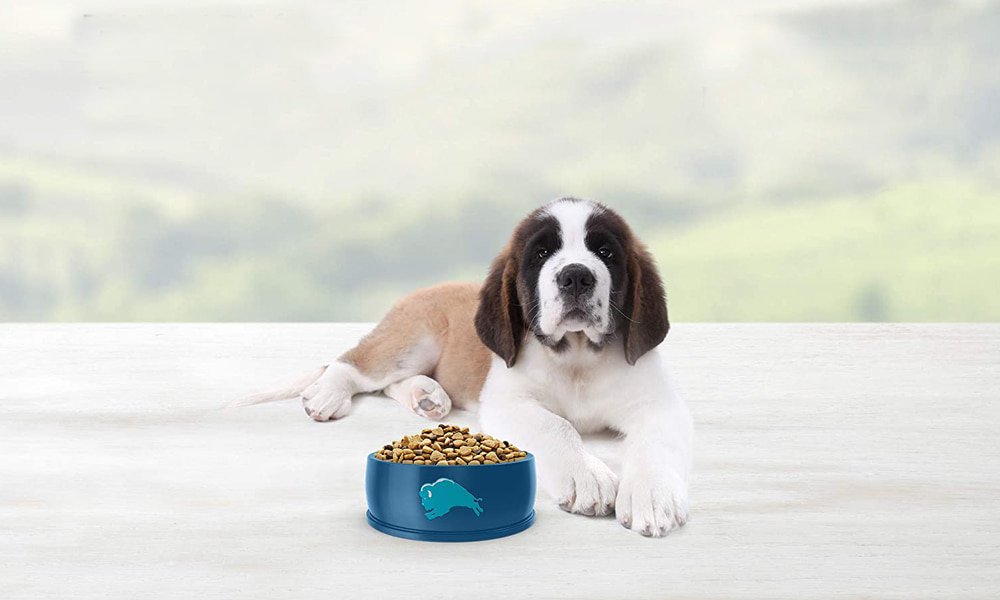
Both wet and dry food can give your puppy what they need. We focused primarily on dry food because it’s more affordable and easiest to store, but it’s important to know about the differences between wet and dry food so you can make up your own mind.
As we said, dry puppy food is more affordable and convenient than wet food. It’s less messy, easiest to measure, and you don’t have to worry about it going bad if it sits in your puppy’s bowl for a while, which also means it’s less wasteful.
Dry food is also more calorically dense. Dry food is usually less than 10 percent water while wet food is as much as 75 percent water. So, dry food definitely gives you more bang for your buck. Your puppy or any large breed dogs will need to eat significantly more wet dog food to get the same amount of nutrition as it will get from a serving of dry food.
Wet foods may be enough for a small puppy, but a large puppy like a Labrador would not be able to get by on wet food alone, which is why we recommend dry dog food.
There are some cases in which you might want to consider mixing some wet food in with your Labs dry diet. Canned foods have ingredients that generally taste a lot better than dry food that puppies sometimes really like, so if you have a picky eater, this may help solve the problem. Wet food has a softer and more appealing texture for Labs, too. If you do decide to mix wet with dry, be very careful to watch your puppy’s intake. Wet food tastes better so puppies may start to want more, so be sure they’re not gaining excess weight when eating these foods.
What about grain?
Some dry dog foods contain a good amount of grain while wet dog food does not. So, if you’re trying to avoid grains for your Labrador puppy, you might be tempted to use wet dog food instead. Corn, wheat, and rice are often used to bind dry dog food and make it possible to have nice bite-sized pieces of kibble. This one way to tell high-quality Labrador puppy food from a low-quality one. While a little bit of grain is okay, especially if it’s natural and sourced responsibly, foods that use a lot of grain usually cut protein, which means that your puppy is ultimately not going to get what it needs to thrive.
There is a lot of debate about whether or not grains are good for dogs and puppies, including your Labrador puppy. One argument is that wolves were carnivores that didn’t eat plant matter or grains so modern domesticated dogs shouldn’t either. Other people believe that wolves were scavengers and would have supplemented their diet with corn, roots, fruits, and vegetables when meat was scarce.
No one knows for sure and we’re not here to try to settle the debate about these ingredients and wet and dry foods for puppies. Ultimately, you’re going to choose what is best for you and your Labrador puppy. Just remember that dry food is a little more economical and nutrient-dense. If you choose to feed your puppies wet food or to mix it with dry to get the benefits of both food and their ingredients, keep a close eye on the number of calories you’re feeding your puppy and watch for excessive weight gain.
Look at the label.
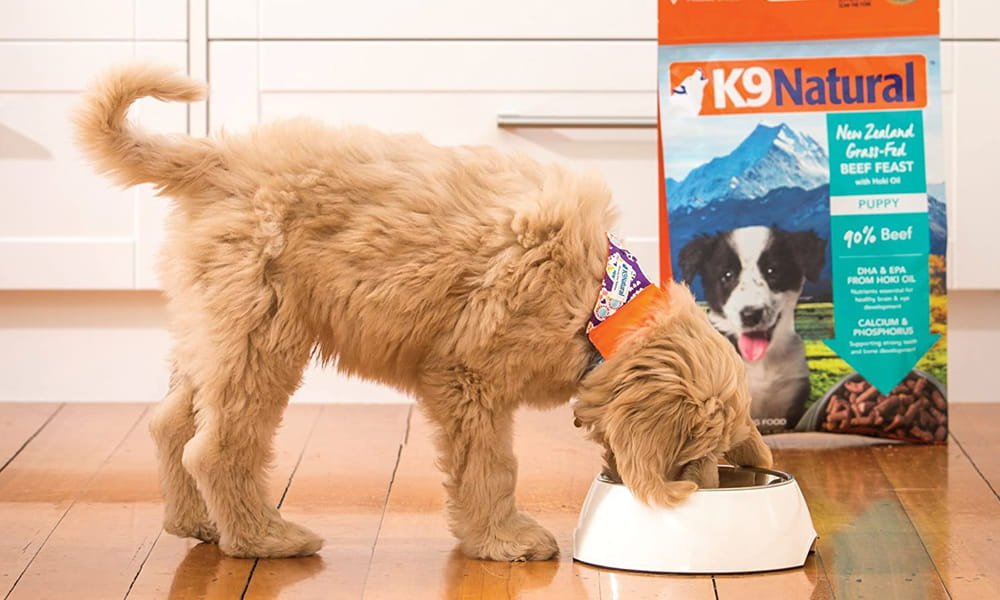
As you can see, nutrition is very important for large breed puppies (like your Labrador puppy) and it is very important to learn how to decipher the label.
You should always be able to find a list of ingredients on the bag. This list is organized in descending order, meaning that the first ingredient is the one that the food contains the most of by weight and is what the puppies who are eating these foods are getting the most of.
The first and second ingredients in good large breed puppy dog foods should always be meat of some kind, whether its chicken, lamb, of beef. You might see meat meal listed as the main ingredient. Like grains, the nutritional value of meat meal is often debated. Meat meal has less water than meat, which means it has more concentrated nutrition. Generally, this is not a bad thing.
What you need to be aware of, though, is the quality of the meal. Some are made of waste products, like bones, hooves, and animal heads. Basically, the parts of the animal that you might not want your puppy to eat. High-quality meat meal doesn’t contain these things, only high-quality meat.
So, meat meal isn’t necessarily bad for your Labrador puppy. It’s only as healthy as the ingredients put into it. What should you avoid? Any dog foods with ingredients described as an animal by-product meal or with a vague description like meat meal. Instead, look for clearly defined, honest ingredients like chicken meal, beef meal, or duck meal. This is the sign of a high-quality concentrated protein that’s good for your puppy.
If you decide to feed your Labrador puppy grains, look for whole grains on the label and avoid things like corn gluten meal or soybean meal.
You should also always avoid artificial preservatives, colors, flavors, and sweeteners.
Dental Health
Another area where dry dog food has an advantage over wet food for your Labrador puppy is that dry food can help maintain good dental health. Some brands are shaped specifically to encourage chewing to scrape off plaque buildup as the puppy chews.
Wet food, on the other hand, is believed to contribute to plaque. Because of its texture, it sticks to the teeth much more than dry food and may cause more plaque.
Some studies done in the 1990s showed that there really was no difference in the dental health of dogs who ate dry adult dog food versus those that ate wet, but things have come a long way since then. Some food brands have developed special shaped and textured pellets that have been proven to scrape off some plaque.
Ultimately, dental health is not the main reason you should choose any food for puppies or Lab adult dogs and you should always be sure to take care of your pet’s teeth with regular brushing. That said, it’s nice to think that the food you choose may help instead of hinder the health of your puppy’s teeth and gums.
The best large breed puppy food helps your Lab puppy dog grow into a healthy adult.
If you have a Labrador puppy or any other large breed puppies, feeding it the best foods for puppy Labs is important to make sure they grow up with healthy bones and joints so that they don’t develop additional health problems as an adult. We gave you 11 great options, including some that are grain-free and all-natural, across all price points so there’s something here for everyone.
Follow the instructions on the side of the packaging to make sure you’re feeding your Lab puppies the right amount of food, and don’t be afraid to ask your vet about when you should begin transitioning your Labrador puppy to food for adult dogs.

I have lived in big cities my entire life. Having grown up on the Upper East Side in Manhattan, my early life was an exciting one, filled to the brim with interesting encounters and opportunities popping up at every street corner. Like many city people, my passion for dogs first started when my parents decided to bring a puppy into the household. For them, it was a way of getting me to spend less time at his computer or wandering aimlessly around the city with my friends. Little did they know that bringing a Labrador Retriever into their apartment would determine not only the course of their son’s professional career but also my love life.
Having obtained a Computer Science Bachelor’s degree from Fordham University, I went on to pursue an IT career in the Big Apple. After a few years of doing basic cybersecurity and tech support work in various offices around Manhattan, I decided to leave New York and look for my calling in Boston, Massachusetts. There, I got a Master’s degree in Computer Science with a specialization in Web Development. As a means of supporting myself through college, he found a salesman job at a local paper company, where he met Mary, the love of my life and the person I’d end up creating My Sweet Puppy with.

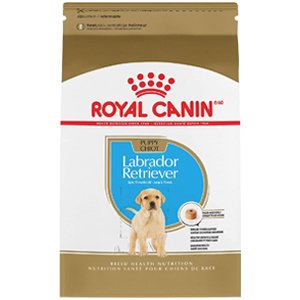
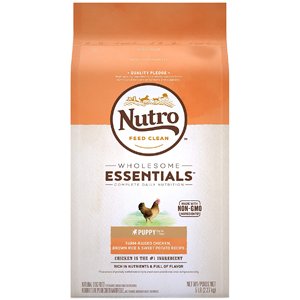
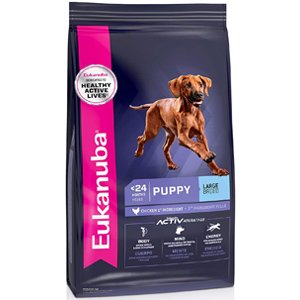

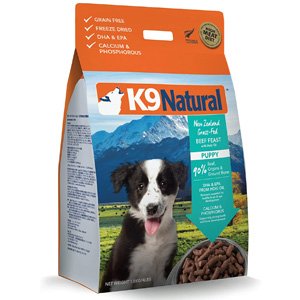
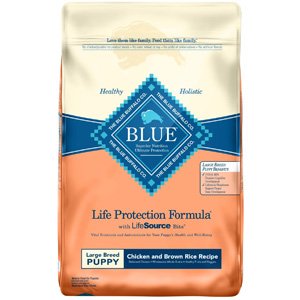
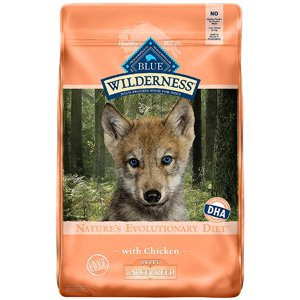
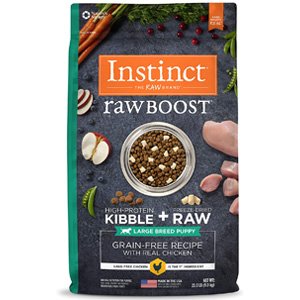
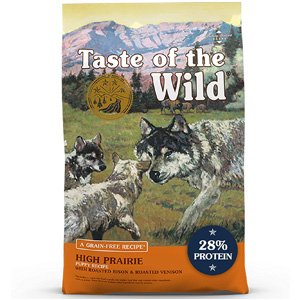
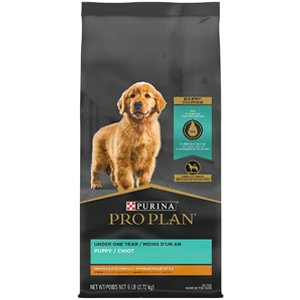

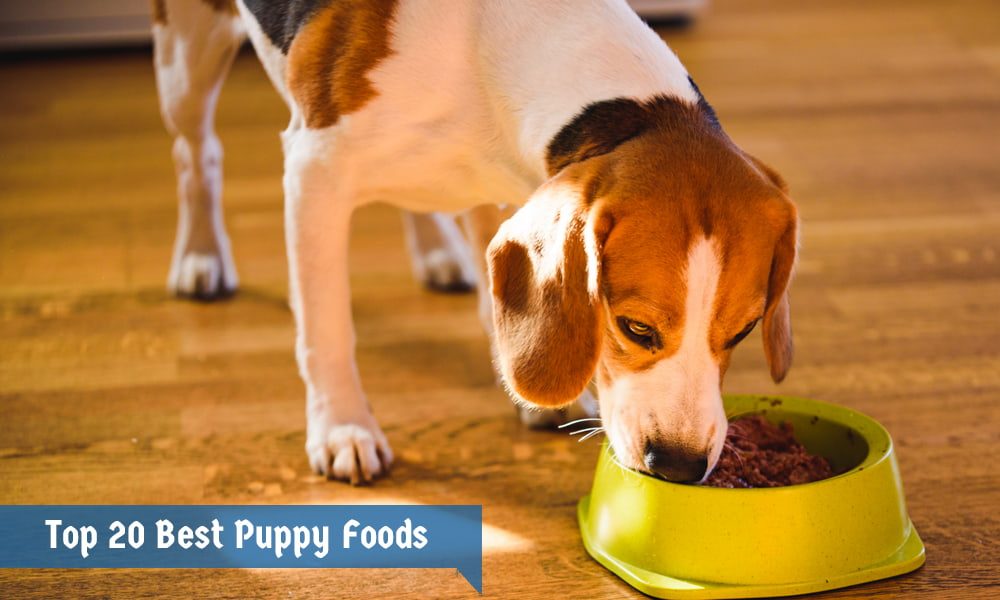
![[REVIEW 2021] Is Blue Buffalo Food A Good Choice For Your Pup?](https://mysweetpuppy.net/wp-content/uploads/2015/10/blue-buffalo-puppy-food-reviews-210x210.png)
My goldador is a Southeastern Guidedog puppy at 13 weeks. He is eating 3 cups high quality dry food and came to us 6 days ago underfed w ribs showing. We were advised to feed 3x a day until he filled in a little more. We were feeding 1 1/2 c each feeding and he adjusted well w no digestive issues. The article opened my eyes that the per meal serving is too large so we are cutting back on portion size today.
Thanks for connecting to Mysweetpuppy.net. Please keep in mind that I, Claudia Bensimoun, do not write any of the blogs or reviews on this website, nor have I in the past. I only answer the comments section.The recommended guidelines on bags often contain more calories than pups/dogs need. Unless it is a very energetic puppy,it is usually best to feed the lower end of the recommendation. Keep in mind that a growing large breed pup needs to be on a large breed puppy food. Choose a dog food according to the lifestage of your dog. Please consult with your veterinarian for advice. Look for formulas that contain probiotics, salmon oil,and that also have calcium and phosphorus levels to help support healthy development of your pup’s teeth and bones.It should also be made with gluten- free ingredients. Eliminating beet pulp, which can act as a stool hardener in pups, is a plus. Also a dog food formula that is free of hormones and steroids is good for pupppies and adult dogs. It should also free of any meat by-products, and offer plenty of fresh fruits and vegetables. Proper, balanced nutrition is important throughout your dog’s life, most especially during puppyhood. Consult with your veterinarian as to how much you should be feeding your pup. All pups should have a full veterinary exam 24-hours after coming home. Hope this helps. Please keep us posted!
Thanks for connecting to Mysweetpuppy.net. Please keep in mind that I, Claudia Bensimoun, do not write any of the blogs or reviews on this website, nor have I in the past. I am in no way connected to the content written within this website, most especially the German Shepherd blog. This website hires other writers for their blogs.Please do not contact me regarding website content. I only write content within the comments section.
I only answer the comments section.Always consult with your veterinarian for the best nutritional advice, most especially concerning puppies.
• Look for dog foods that are tested using the AAFCO feeding trials instead of by formulation.
• Look for the nutritional adequacy statement that is required on all pet food labels.
• This label provides answers to three most important questions about your pet food.
• If it’s complete and balanced
• What life stage is it intended for? (Puppy, senior, etc.) Make sure you’re feeding a high-quality puppy formula
• How the claims on the label are substantiated
Dog parents need to know that the life stage that a pet food is marketed for, may not be the same life stage for which the food actually meets the minimum requirements. When asked to comment about certain dog food brands, Tufts added that they could not comment specifically about any brand because each pet and their dietary requirements are different. Also each pet food manufacturer has different products, so it’s too difficult to rank the order, and name anyone specifically as being the best, since there are so many variables involved. Puppy food needs to be health and made from high-quality ingredients.
Most of us understand the importance of eating healthily, but many don’t fully understand that this applies to our furry friends, too. Vitamins and amino acids should not be synthetic, and organic should mean that all of the ingredients are organic, including vitamins and minerals, and not just a few. A well-balanced dog food should use real meat as its first ingredient. It should also not use harmful preservatives, flavors or artificial colors. Stay away from all made in China puppy dog food and treats.It’s also important to look at the AAFCO regulations.
AAFCO Regulations
AAFCO model regulations and the federal feed laws stipulate that all pet food labels need to list all the ingredients in their pet food. This is done in descending order according to the weight of each ingredient listed. With that said, it’s easy to see where the most important sources of calories and proteins are coming from-the first five ingredients listed. The first ingredient is the one ingredient that is present in the highest amount.
It’s also important to know everything there is to know about your dog’s health.
Always ask yourself these questions: Is my dog suffering from any health problems? What life stage is he or she at? Veterinarians recommend that dog owners have a better understanding of their dog’s health issues and life stage before choosing a dog food.
Most importantly, the puppy food that you choose to feed your puppy should be tailored specifically to his breed.
That said, here’s what to look for when choosing a high-quality puppy food for your puppy.
•The dog food formula must be made by a reputable and knowledgeable dog food company that has the highest quality control measures.
•Dog food should not be made in China, nor should any of the ingredients originate from China.
•Puppies should only eat a puppy food formula, and should always be fed a puppy formula.
•Large breed pups like the Great Dane or German Shepherd need to be on a large breed puppy diet to ensure correct growth, and no growth abnormalities.
•Formulas should contain antioxidants, Omega 3’s, healthy ingredients and a balanced diet for the appropriate life stage.
A Few Tips About Puppy Care Diet’s
The correct nutrition is most important for your puppy. Feeding your puppy a high-quality diet during puppyhood is critical for development and brain health. All pup’s need to consume the right amount of calories,vitamins,fat,protein and minerals to ensure the correct growth and development. Puppies should be fed several times a day with a specially formulated puppy food. As your puppy gets older, the multiple daily feedings can be decreased, yet you’ll still need to feed a specially formulated puppy diet until adulthood. Some large breeds can take up to 2 years to reach adulthood, with most dogs reaching adulthood at about 9-12 months.
According to the AAHA, pups and dogs need to be fed a few times a day.
Puppies from 8-12 weeks require 3 meals a day
Puppies 3 months to 6 months require 2 meals per day
Puppies 6 months to one year require twice daily feedings
Dogs one year and older require 2 meals a day
Large dog breeds may require 3 meals a day
Caring For Your Puppy, visit: https://www.aaha.org/pet_owner/pet_health_library/care_sheets/caresheet_dog_or_puppy.pdf
Thanks for connecting to Mysweetpuppy.net. Please keep in mind that I, Claudia Bensimoun, do not write any of the blogs or reviews on this website, nor have I in the past. I only answer the comments section.
Thanks for connecting to Mysweetpuppy.net. Please keep in mind that I, Claudia Bensimoun, do not write any of the blogs or reviews on this website, nor have I in the past. I only answer the comments section.
The best puppy food for the lab is to Nutro Wholesome Essentials puppy dry dog food formula that contains real, farm-raised chicken, brown rice, & sweet potatoes recipe dry dog food always starts with great-tasting. Farm-raised chicken is the first ingredients that contain amino acids necessary for building muscle and maintaining a healthy metabolism.
Thanks for connecting to Mysweetpuppy.net. Please keep in mind that I, Claudia Bensimoun, do not write any of the blogs or reviews on this website, nor have I in the past. I only answer the comments section.
At Mysweetpuppy.net we are continuously striving to give our readers the most accurate and updated information. Dog food formulas should contain no artificial flavors, colors or preservatives such as propylene glycol.
Here’s what to look for:
•Diets should include whole foods instead of processed foods.
•They should also use real meat instead of meat meal.
•Organ meats are good.
•Look out for by-products such as organ meats which are fine, but no non-meat parts.
•There should be a good source of calcium in the dog food formula.
•The formulas should contain vegetables for fiber and nutrients such as flavonoids.
•Diets need to be tested using AAFCO feeding trials, or by formulation to meet AAFCO nutrient profiles
•There must be specific quality control measures to assure consistency and quality of all Ingredients used, as well as for the end product.
•All dog food diets should be complete and balanced.
•The dog food formula should indicate what life stage it is intended for.
•Puppies should only eat a puppy food formula, and should always be fed a puppy formula.
•Large breed pups like the Great Dane or German Shepherd need to be on a large breed puppy diet to ensure correct growth, and no growth abnormalities.
•Formulas should contain antioxidants, Omega 3’s, healthy ingredients and a balanced diet for the appropriate life stage.
Opt for no chicken meal products or other rendered animal parts. Dog food should not use any of the 4D products: diseased, disabled, dying and dead (before being slaughtered) in their dog food.The addition of cellulase and cellulose as fillers can be problematic. For those unaware, cellulase breaks down cellulose. Many dogs have problems with both because it causes digestive problems.Look for high-quality ingredients such as whole meats, fruits, vegetables, and grains, and take heed of the different ratio of macronutrients- proteins, fats and carbs.
Consult with your veterinarian if you need advice!
What are the advantages of feeding dehydrated dog food? Is it healthier than dry or wet food?
Thanks for connecting to Mysweetpuppy.net. Please keep in mind that I, Claudia Bensimoun, do not write any of the blogs or reviews on this website, nor have I in the past. I only answer the comments section.
The Benefits of Dehydrated Dog Food
Dogs give us their everything: friendship, love and loyalty! In return, we should give them the very best nutrition. If you want to see which dog foods make a difference and keep Fido healthy, you don’t have to spend a lot of money. Dehydrated dog food is easy to feed, and always comes with clear instructions.
• Minimally processed
• High moisture content
• Whole foods
• Human grade
• Convenient
• Dehydration process leaves behind natural ingredients that support immunity and good health
• Stable shelf life
• Does not need refrigeration
• Color, flavor, vitamins, minerals and phytonutrients not impacted by dehydration process
• Cheap shipping costs
That said, dehydrated dog food have some drawbacks.
• Not as many brands to chose from
• May be more costly
Dry Dog Food also has many benefits!
• Easy to feed with clear instructions for new pet parents
• Available in many different varieties
• Excellent for travel
• Easily combined with canned foods or fresh foods
• High- quality brands
• Available in your veterinarian’s office, traditional pet stores, and online
• Available in grain-free, gluten-free, and vegetarian options
• Not messy
• Contains complete and balanced nutritional requirements as recommended by veterinarians
• Can be heavy to carry or ship
• Can become contaminated with mold if not stored properly
• Numerous recalls due to bacteria, salmonella, mycotoxins and nutrient concerns
• Cheap dry dog food brands may have lower- quality ingredients
• Constant need to check for a balanced ingredient list
• Some by-products used in formulas
• Can cause obesity in dogs
Wet or canned dog foods
• Easily combined with dry kibble
• Must inspect first five ingredients
• Need to watch out for thickener’s like “gum” used
• Necessary to stay away from wheat gluten that is used in wet foods to bind the protein content of the food
What’s good about wet dog food?
• Easy to feed with clear instructions for new pet parents
• Easy to carry
• Numerous “complete and balanced” brands that are high quality
• Numerous varieties such as turkey, chicken, beef, liver and duck.
• Supplemental varieties available for a varied diet
• Convenient when your dog needs a change of diet
What’s bad about wet dog food?
• Meat by-products that may not be clean or refrigerated
• Wheat gluten as an ingredient used
• Unnamed animal and protein sources
• Sometimes contains sweeteners or sugars
• Ingredients like preservatives, flavors, artificial colors, hormones
• Fat content may be high in many formulas
• Water may be first ingredient, with the second being wheat gluten (cheaper brands)
• Vegetables may come in as the eighth or ninth ingredient, which means that there’s hardly any vegetables in the formula
• A need to check ingredient labels repeatedly, most often when switching brands to make sure that you’re not falling for the pretty packaging
Always ask yourself these questions: Is my dog suffering from any health problems? What life stage is he or she at? Veterinarians recommend that dog owners have a better understanding of their dog’s health issues and life stage before choosing a dog food. And as usual, always consult with your veterinarian for advice!
For more about a study demonstrating how unusual pet diets may be linked to heart disease, visit: https://www.avma.org/News/JAVMANews/Pages/180801e.aspx
For 2019 dog food recalls, visit:https://www.petful.com/recall-lists/dog-food-recalls/
What are the disorders associated with excessive vitamin d in dog food
According to Newsweek “The United States Food & Drug Administration found that there were six different brands of dog food with potentially dangerous levels of Vitamin D on the market in November alone.The food is being recalled for containing potentially high levels of the vitamin that could be harmful to animals that eat it. An unusually high amount of Vitamin D in dogs can cause serious health issues like renal dysfunction.” The article goes on to describe the symptoms that your dog may have from eating a dog food formula that has high levels of vitamin D. “Symptoms in dogs of ingesting too much Vitamin D include vomiting, loss of appetite, thirst, frequent urination and drooling as well as weight loss. Those symptoms are serious and can be dangerous for the animal so anyone with an animal showing those symptoms should contact their vet as soon as possible,” via Newsweek.
The FDA has a list up with all the dog food brands affected.
According to the Association of American Feed Control Officials (AAFCO), “Ingredients must be listed in order of predominance by weight, on an “as formulated” basis. The ingredient that makes up the highest percentage of the total weight as it goes into the product is listed first. Each ingredient must be listed by its appropriate name. There is no allowance to group ingredients smaller than some percentage (like 1% or 2%). There is no allowance in pet foods to use a collective term for replacing individual ingredient names with a group term, like combining wheat, corn and oats into one ingredient name “grain products”.” “Additionally, there is no allowance for dietary supplements for animals.The Dietary Supplement Health and Education Act (DSHEA) does not apply to animals. For animals there are only two categories: food or drug. Be advised that some ingredients used in dietary supplements for humans cannot be used as pet food ingredients.”
Vitamin D
.Is obtained through a dog’s diet or from sunlight
.When vitamin D is reduced, calcium and phosphorus absorption is also reduced
.Deficiencies of calcium, phosphorus, and vitamin D may result in defective bone formation, and abnormalities of the bone. Nutritional and metabolic complications can occur as well.
.Excess calcium fed to giant sized breeds like the Great Dane may result in osteochondrosis and hypertrophic osteodystrophy
.Osteomalacia affects adult dogs in the same way as rickets with fractures being commonly seen, and deformities in the spine. Diet needs to be evaluated by a veterinarian and corrected.
What is Rickets in Puppies?
This is a rare disease in pups caused by lack of vitamin D or phosphorus in the diet. It results in soft or deformed bones. Primary treatment is to alter diet, and increase sunlight exposure via ultraviolet radiation or sunlight exposure to increase the production of vitamin D. That said, it’s important to have your veterinarian monitor all homemade diets to ensure that the diet is not deficient in minerals. All homemade dog food diets need to have the correct balance of calcium-to- phosphorus ratio. If feeding a commercial dog food diet, it’s important to only feed high-quality puppy or dog food diets.
Excess Vitamin D May Cause
.Excess thirst
.Vomiting
.Loss of appetite
.Increased urination
.Drooling
Tips For Choosing a Puppy or Dog Food Formula
.All dog food formulas must meet the AAFCO profiles for all life stages, and must meet the minimum nutrient levels for growth and adult maintenance in dogs.
.A reputable and knowledgeable dog food company that has the highest quality control measures must make the dog food formula.
.Dog food should not be made in China, nor should any of the ingredients originate from China.
.Puppies should only eat a puppy food formula, and should always be fed a puppy formula.
.Large breed pups like the Great Dane or German Shepherd need to be on a large breed puppy diet to ensure correct growth, and no growth abnormalities.
.Formulas should contain antioxidants, Omega 3’s, healthy ingredients, and a balanced diet for the appropriate life stage.
.Dog food formulas should contain no artificial flavors, colors or preservatives such as propylene glycol.
.There should be a good source of calcium in the dog food formula.
.The formulas should contain vegetables for fiber and nutrients such as flavonoids.
.Diets need to be tested using AAFCO feeding trials, or by formulation to meet AAFCO nutrient profiles.
.A well-balanced puppy or dog food should use real meat as its first ingredient. It should also not use harmful preservatives, flavors or artificial colors.
.Always consult with your veterinarian for advice before purchasing a dog food formula for your pooch.
.Always read the ingredients list since changes in formula do occur.
.Check for dog food recalls regularly.
For the safety reporting portal (SRP)
For my article in the USDAA, visit: http://www.usdaa.com/article.cfm?newsID=2919
For my article on Paw Preference in Agility, visit:http://www.usdaa.com/article.cfm?newsID=2623
Thanks for connecting to Mysweetpuppy.net. Please keep in mind that I, Claudia Bensimoun, do not write any of the blogs or reviews on this website, nor have I in the past. I only answer the comments section.
Can I use glucosamine for arthritis instead of NSAIDS
Joint problems affects dogs of all ages, with senior dogs having the most problems. That said, osteoarthritis is painful, and is the most common joint disorder in canines today. Signs may include lameness, joint swelling, and pain. There is also wasting away of muscle, and thickening and scarring of the joint membrane during osteoarthritis. Veterinary treatments can be surgical or medical in nature with the use of non-steroidal anti-inflammatory drugs to help with pain and inflammation. Sometimes the longterm use of these drugs may cause intestinal problems in dogs.
Corticosteroids are given for a short period of time to help with inflammation. It’s always best to consult with your veterinarian for the best treatment. Your veterinarian may advise as to a weight-loss program for your pooch, and also advise you to exercise on softer ground. There are also numerous joint- fluid modifiers that your veterinarian may recommend.
In a 2017 study published by Open Veterinary Journal, Glucosamine and Chondroitin are both discussed for their use in arthritic dogs. The study adds ” Osteoarthritis is a slowly progressive and debilitating disease that affects canines of all breeds. Pain and decreased mobility resulting from osteoarthritis often have a negative impact on the affected canine’s quality of life, level of comfort, daily functioning, activity, behaviour, and client-pet companionship. Despite limited and conflicting evidence, the natural products glucosamine hydrochloride (HCl) and chondroitin sulfate are commonly recommended by veterinarians for treating osteoarthritis in dogs.”
The study goes on to add that “the etiology of osteoarthritis’ pathology may include defective articular cartilage structure, inadequate cartilage biosynthesis, joint trauma, instability, and inflammatory mechanisms. The disease presents with symptoms such as pain, stiffness, lameness, and disability (D’Altilio et al., 2007).
“Non-steroidal anti-inflammatory drugs (NSAIDs) are the current gold-standard pharmaceutical therapy for dogs with osteoarthritis; however, NSAIDs may cause gastrointestinal ulceration as an adverse effect and are contraindicated in the presence of renal insufficiency or dehydration. Other pharmaceutical options include diacerhein, corticosteroids, and hyaluronic acid (Henrotin et al., 2005). Select nutraceuticals such as glucosamine, chondroitin, pentosane polysulphate, avocado/soybean unsaponifiables, green-lipped mussel, and milk protein have also been used (Henrotin et al., 2005). The study also discusses how ” Glucosamine hydrochloride (HCl) and chondroitin sulfate (CS) are commonly recommended natural health products for treating osteoarthritis in dogs (Rychel, 2010).
“Glucosamine regulates the synthesis of collagen in cartilage and may provide mild anti-inflammatory effects while chondroitin sulfate inhibits destructive enzymes in joint fluid and cartilage. The two nutraceuticals also contribute to the synthesis of glycoaminoglycans and proteoglycans, which are building blocks for the formation of cartilage (Beale, 2004).” via Open Veterinary Journal.
The study concludes that “based on the available literature, the potential benefits of glucosamine and chondroitin use in osteoarthritic canines can neither be confirmed nor denied. Glucosamine and chondroitin use in canines requires further clinical study using improved methodology. Clinical trials conducted to date have yielded mixed results.Glucosamine and chondroitin are commonly recommended by veterinarians as an alternative for treating osteoarthritis in canines unable to tolerate the adverse effects of NSAIDs, or as add-on therapy. Although glucosamine and chondroitin have benign adverse effect profiles, the clinical benefit of using these agents remains questionable. The available evidence is difficult to interpret due to the use of different manufacturers, salt forms, compositions, sources, strengths, regimens, therapy durations, and combinations of active ingredients. Further study is required in order to clarify the uncertainty around the clinical benefit of using these agents and quantify any treatment effect that exists.”
For more on this study, visit: https://www.ncbi.nlm.nih.gov/pmc/articles/PMC5356289/
A note for pet parents using glucosamine. There is both Glucosamine hydrochloride and glucosamine sulfate.
Glucosamine hydrochloride (HCL), an amino sugar helps to stimulate growth of cartilage cells. According to DMV 360, DR. Brunke,” Glucosamine hydrochloride is an amino sugar, but it’s not involved in the glucose pathway. It’s a building block of the cartilage matrix and stimulates growth of cartilage cells. Glucosamine is readily available, cheap and can be given safely to diabetic patients”, adds Dr. Brunke.
“Notice that we’re discussing glucosamine hydrochloride, here, not glucosamine sulfate. Although glucosamine sulfate is absorbed better, there have been no studies published showing that glucosamine sulfate actually shows up in synovial tissue after it’s been ingested orally. A joint supplement doesn’t help if it doesn’t get where it needs to be.” He goes on to discuss the dosage, ” loading dose of two times maintenance for four to six weeks is required for glucosamine hydrochloride to reach therapeutic levels. Maintenance is 500 to 1,000 mg for a 75-lb dog, which works out to about 15 mg/kg.”
As for Chondroitin Sulfate,Dr Brunke adds “This supplement works by inhibiting cartilage-destroying enzymes, but it’s difficult to source and extract, which raises the cost. Chondroitin is a large molecule with variable absorption, though some companies produce a low-molecular-weight version that can increase absorption from the gastrointestinal tract.”
“Chondroitin requires a loading dose similar to glucosamine, and the standalone dosage is the same as glucosamine. When given with glucosamine, chondroitin has a synergistic effect, and has been shown to lessen inflammation if given before a joint injury in dogs,” says Dr.Brunke.
Omega -3 Fatty Acids also supports joint health in dogs. A study concluded that when carprofen was given together with Omega-3’s, arthritic dogs needed less carprofen.
Eggshell membrane contains glucosamine,chondroitin,hyaluronic acid and collagen, yet there are no studies to show that this works for canine arthritis, yet studies in humans demonstrate that eggshell membranes do help. Movoflex soft chews may help to support joint health in dogs.
Green-lipped mussels (not farm raised) may help due to the high levels of Omega- 3 fatty acids. For more on Dr. Brunke’s article, visit: http://veterinarymedicine.dvm360.com/joint-supplements-dogs-helpful-vs-hype
A study published in Science Daily discussed the benefits of physiotherapy for arthritic pets.
That said, always consult with your veterinarian as to the best advice when it comes to supplements for your dogs!
For more on hip dysplasia, visit:https://www.usdaa.com/article.cfm?newsID=2288
Thanks for connecting to Mysweetpuppy.net. Please keep in mind that I, Claudia Bensimoun, do not write any of the blogs or reviews on this website, nor have I in the past. I only answer the comments section.